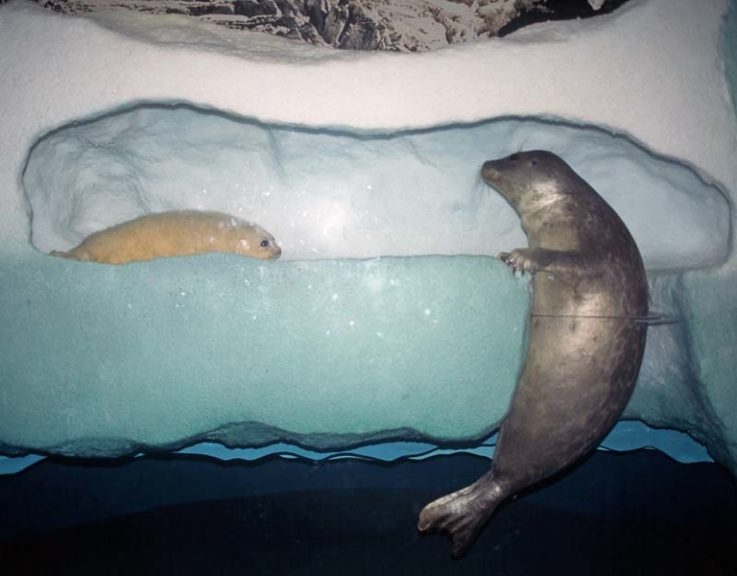Ringed seal
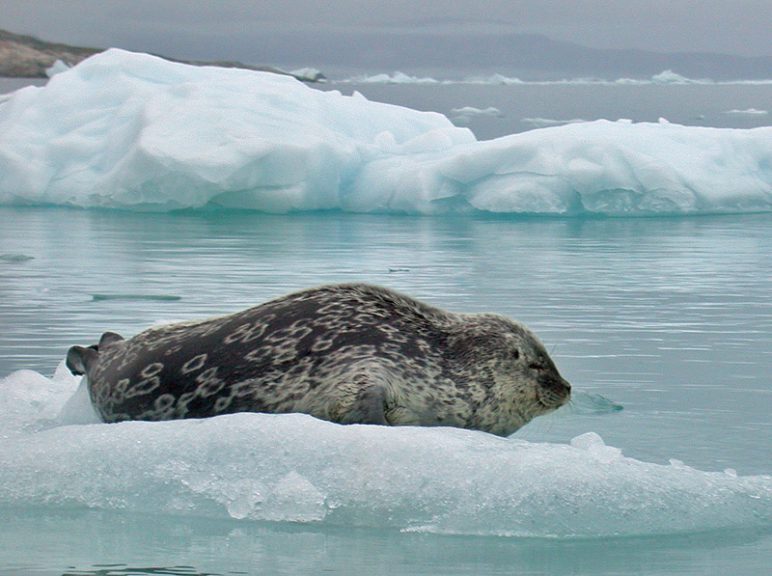
A ringed seal in Disko Bay. Photo: Carsten Egevang.
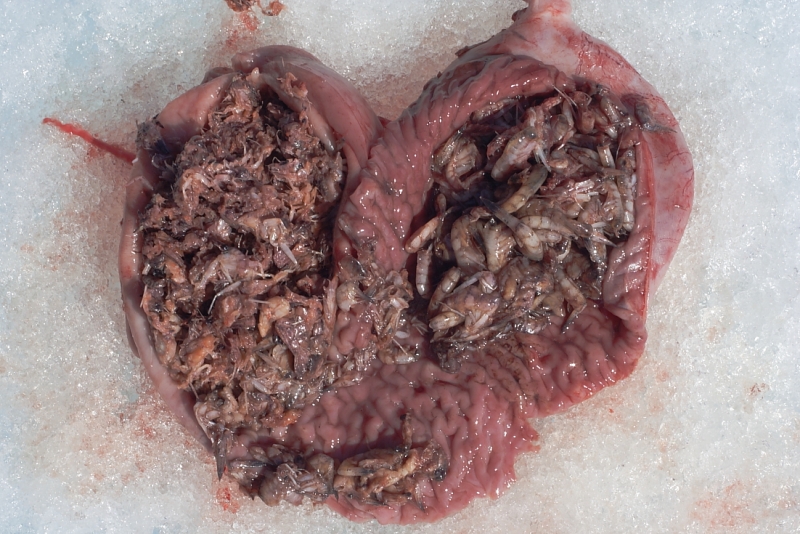
Ringed seal stomach, cut open showing content of Themisto.
Pusa hispida
Size
The ringed seal (Pusa hispida) is the smallest of the Greenlandic seal species. The length of sexually mature, adult individuals typically varies from 1.10 metres to 1.45 metres from snout to tip of the tail, and the weight is between 50 and 110kg in winter when they are fattest. Most ringed seals are thinnest in the summer, when they will on average have lost about 1/3rd of their winter weight. Sometimes, however, larger ringed seal up to 1.70m and 150 kg are caught. These large ringed seals are abundant in Kangia (the Jacobshavn Icefjord near Ilulissat) Ringed seals in Disko Bay are therefore names as “kitaajaqqat” (the small ones from west), which is the smaller type that is caught all along the west coast and Kangiata natsiit, which are the large ones from the fjord. Some of the large ringed seals are also caught north of Ilulissat, but their numbers are rapidly declining with the distance from the Icefjord. How different the two types are genetically, morphologically and behaviourally are not descriped in details and it is still unknown whether they should be regarded as two different subspecies that has to be managed separately.
Food
Most of the ringed seals around Greenland live in the ice-filled regions of North and East Greenland, where they mostly eat polar cod and parathemisto (a kind of amphipod – see picture). Their diet becomes more varied in subarctic, where such as capelin, Greenland cod and krill are often on the menu.
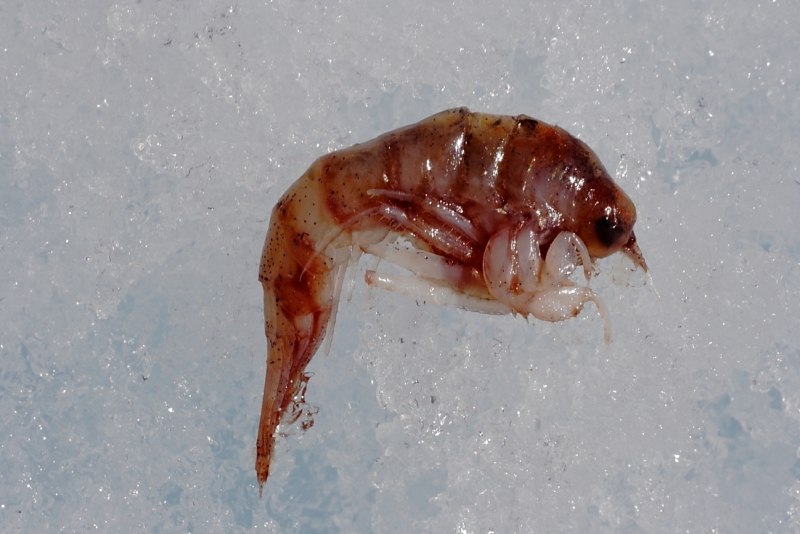
Themisto.
Reproduction
The pups are born in March or April in a cave dug into a snowdrift. At birth, they are about 60cm long and weigh about 4.5kg. Data from fast ice areas in Canada show that pups suckle for 6-7 weeks, and ringed seal pups from there are on average around 88cm long and weigh 22kg when they are abandoned by their mothers. Ice conditions though can greatly influence the length of the suckling period. Data from drift ice fields in the Sea of Okhotsk show that there they only suckle for around 3 weeks. Mating is assumed to take place at the end of or just after the suckling period. The diving behaviour of the males (many shallow dives) and bite marks on the body indicate that they actively defend territories under the ice. They will often emit a strong smelling secretion from glands in the face. This is used to mark breathing holes and caves and their meat has a different flavour when they are in this mode, called tiggak. Males in tiggak may in some areas meet throughout the winter from the beginning of the ice cover, so this phenomenon is not confined to the breeding season.
Model of ringed seal with pup in snow cave on top of the ice. Photo: Aqqalu Rosing-Asvid.
Moulting
A few ringed seals begin to moult (shed hair) as early as late April and the males can well be both tiggak and moulting at the same time. The number of moulting seals increases in May and peaks in June.
Distribution and numbers
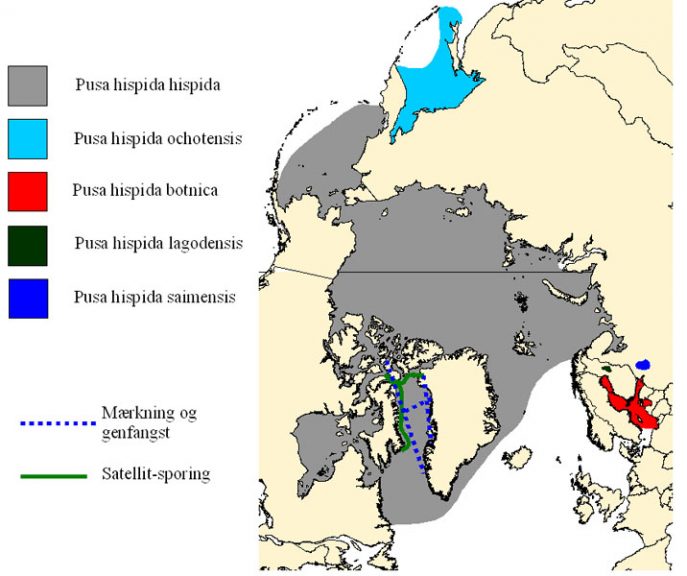
The figure shows the distribution of the different subspecies of the ringed seal. The blue dotted line shows where seals with flipper tags have been recaptured. The green line marks a satellite tracking of ringed seals from Qaanaaq to southern Baffin Island.
Ringed seals have a circumpolar distribution and are found in almost all northern areas where winter ice regularly forms. Ringed seals are divided into five subspecies of which the Arctic ringed seals (Pusa hispida hispida) are by far the largest group. It is uncertain how many ringed seals there are in total, but an educated guess of 6-7 million has been put forward. Of these, approx. 1 million are of the subspecies Pusa hispida ochotensis, while the other three southern subspecies together only constitute in the region of 10,000 individuals. The density of Arctic ringed seals has not been estimated in its entire distribution area. The estimate of about 5 million Arctic ringed seals is thus partly based on extrapolation. Based on surveys average densities of ringed seals has been calculated for various types of sea ice (ex. fast ice in fjords, fast ice along the coasts and pack ice). Based on satellite maps it has then been calculated how many km2 exist of the various types of sea ice and the areas have then been multiplied with the estimated densities, to give a rough estimate.
The Arctic ringed seals can probably be divided into several distinct populations between which there is little interchange. For example, it is believed that only a few ringed seals cross the open water between the ice in Baffin Bay/Davis Strait and the belt of field ice in East and South-west Greenland. On the other hand, recapture of ringed seals with flipper tags and satellite tracking show that ringed seals swim back and forth between West Greenland and eastern Canada.
Status
The even distribution of ringed seals throughout the Arctic makes them much more robust against overexploitation compared with the seals which gather and breed concentrated in specific areas. Ringed seals are thus classified as not threatened in the Greenland Red List.
Management
Advice on hunting and management comes under NAMMCO, and here, in 1995, they were asked to prepare an advisory document which, among other things, would shed light on whether the relatively large catch of ringed seals is sustainable. Work on this advisory document indicated that there are still large gaps in our knowledge of ringed seals. In particular, we know little about the ringed seals residing in open water drift ice areas in winter. Nevertheless, the ringed seal was found to be “not threatened” on the grounds of the ringed seals’ even distribution over a very wide area. The vast majority of the ringed seals live out of reach for the hunters. At the same time, analysis of the catch shows that it consists mainly of young, sexually immature animals, whichreduce the effect of the catch on population dynamics. The catch can, however, reduce the number of ringed seals locally and local regulations(which exist in some areas) can therefore increase the abundance and productivity of ringed seals that live close to the hunting areas.
Research
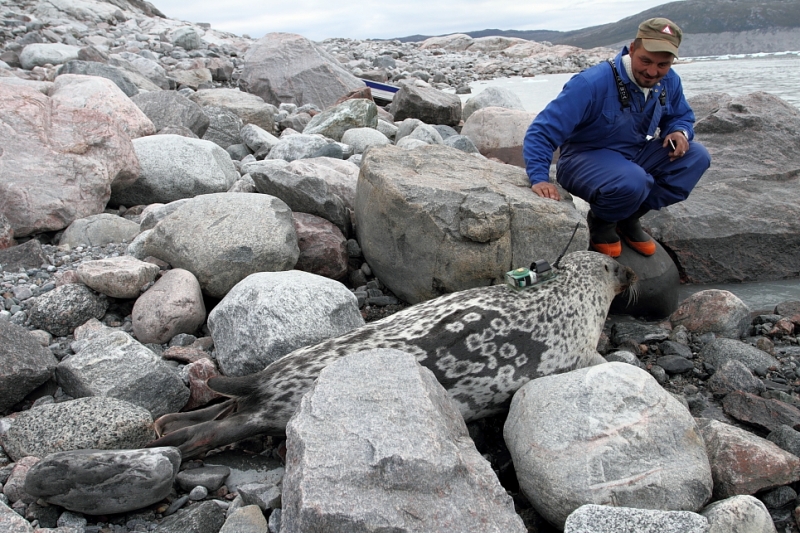
Large ringed seal from Kangia (Jacobshavn Icefjord), with data-logger that collect and transmit (through satellites) data about the salinity and temperature down through the water column.
Ringed seal behaviour can differ significantly in different areas. Some places hold a high concentration of local stationary seals, whereas other areas have many migratory seals that swim long distaces. It is a large and expensive task to identify the movement patterns of ringed seals throughout their distribution area. Fortunately for this research, oceanographers have become aware that satellite transmitters on seals can also be used to gather data on water temperature and salinity down through the water column when the seal dives. Here the ringed seal in particular can be useful because many ringed seals live in ice-filled waters where it can be impossible or very expensive and difficult to get around by boat. Transmitters on these seals give data on both the oceanographic conditions and on seal behavior.
You can read more HERE

